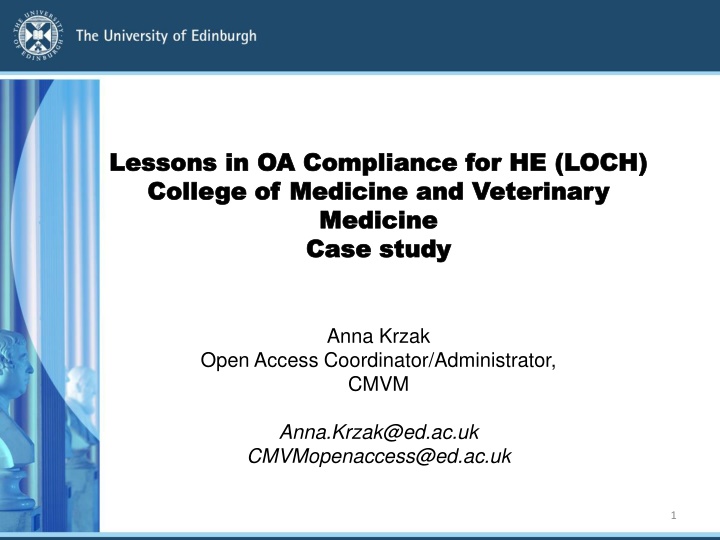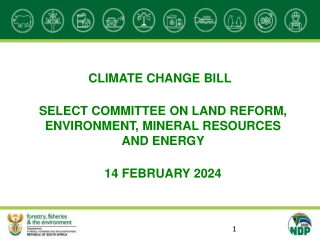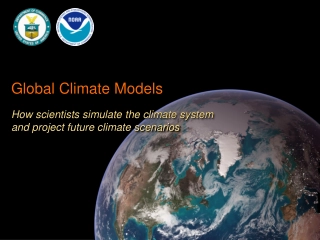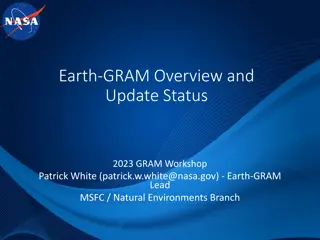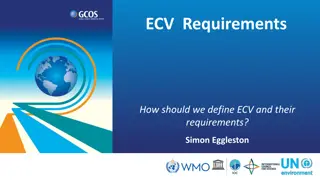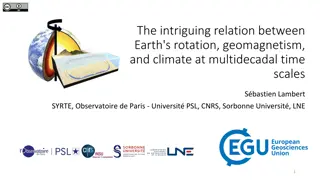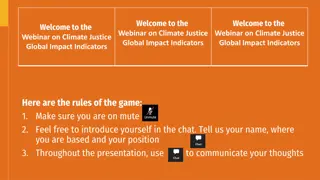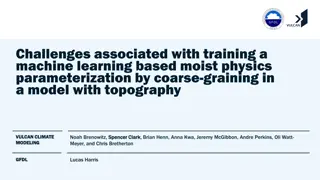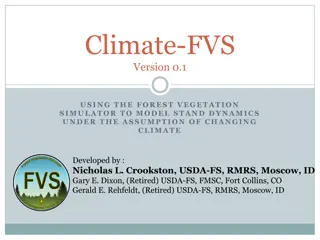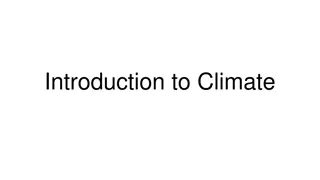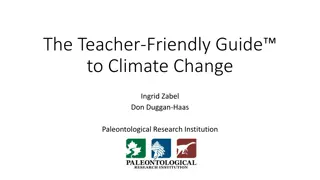Teaching Earth's Climate with Student-Friendly Global Model
Earth's climate presents unprecedented challenges, yet public awareness remains low. This project focuses on enhancing climate literacy through model-based teaching, aiming to bridge the gap in science education. By utilizing a cloud-based global climate model, EzGCM, students gain a deeper understanding of climate concepts and scientific modeling techniques. The research questions center on the implementation and impact of this innovative curriculum in secondary science classrooms.
Download Presentation

Please find below an Image/Link to download the presentation.
The content on the website is provided AS IS for your information and personal use only. It may not be sold, licensed, or shared on other websites without obtaining consent from the author.If you encounter any issues during the download, it is possible that the publisher has removed the file from their server.
You are allowed to download the files provided on this website for personal or commercial use, subject to the condition that they are used lawfully. All files are the property of their respective owners.
The content on the website is provided AS IS for your information and personal use only. It may not be sold, licensed, or shared on other websites without obtaining consent from the author.
E N D
Presentation Transcript
Lessons Lessons in OA Compliance for HE (LOCH) in OA Compliance for HE (LOCH) College of Medicine and Veterinary College of Medicine and Veterinary Medicine Medicine Case Case study study Anna Krzak Open Access Coordinator/Administrator, CMVM Anna.Krzak@ed.ac.uk CMVMopenaccess@ed.ac.uk 1
College of Medicine & Veterinary College of Medicine & Veterinary Medicine (CMVM) Medicine (CMVM) Research-intensive institution: approx. 33k research outputs recorded in PURE Recent REF 2014 placed our Vet School top in the UK; Medicine and Neuroscience at UoE were both top five* Medicine was the University of Edinburgh s largest REF submission and one of the largest in the UK as defined by research power 2 *I am not bragging at all - Just saying that there is an extra pressure to perform even better in the next REF
Structure Structure 2 Schools Vet School and Medical School with 3 Deaneries 5 Research Institutes each with more than 500 staff and postgraduates Many interdisciplinary Research Centres - including: 4 MRC Centres, BHF Centres, a CRUK Centre, an Asthma UK (A-UK) Centre, a BBSRC funded institute an and a WHO Collaborating Centre on Population Health Research and Training Division of Health Sciences with sub-units Multiple sites across Edinburgh 3
What would we like to achieve? What would we like to achieve? Compliance with REF OA Policy ensuring that CMVM research papers are eligible for the next REF Increased compliance with other funders' mandates, especially MRC, BBSRC and Wellcome Trust Increased awareness of OA and its benefits OA integrated into researcher's publishing practices 4
Challenges (some of them) Challenges (some of them ) New point of intervention date of acceptance Time constraints Research staff needs to engage with the policy requirements Confusing requirements (e.g. embargoes, etc.) A large number of papers is produced on a regular basis A complex structure of the College (multiple sites) - a big challenge in terms of ensuring that everyone is aware of the requirements - loads of advocacy and training! 5
Challenge Possible Solution Deposit on acceptance How do we identify newly accepted articles? Example: Clear responsibilities: It s the academic responsibility to send the correct files to local administrator message repeated at OA meetings, research committee papers, etc. Multi-author papers e.g. authors unaware of acceptance, difficulties in obtaining AAM from external authors Example: Advise authors to make their OA responsibilities clear to other co-authors No robust evidence base against which we could benchmark our compliance How do we know that we ve managed to capture every paper in PURE? Example: Regular scanning of external databases, e.g. Scopus, Web of Science or Science Direct, etc. Not perfect but we need to have a bigger picture and some sort of safety net 6
College OA Workflow College OA Workflow Research Centre Administrator/s Research Centre Administrator/s College Research Centre Administrator/s OA Coordinator Research Office Research Centre Administrator/s Centre admin staff (administrators, PAs, secretaries, lab managers etc.) are the local OA contacts for the deposit of accepted manuscripts. They also update and validate papers in Pure on publication. Research Centre Administrator/s 7
Arrangements Arrangements (Locally) mediated deposit (Locally) mediated deposit 8
Communications Communications so far kick-off meetings with the senior admin staff from each centre/unit visiting each centre/site and learning about the local working practices to ensure that the new workflows are fitted in seamlessly within the already existing processes email from the Head of College to all staff OA updates as the standard item on the College Research Committee agenda monthly reminders sent by local administrators And more every day! so far... ... 10
OA Admin training sessions OA Admin training sessions Open access-related terminology Benefits of Open Access it s not just about compliance Different versions of papers (with examples) Basic publication workflow Detailed overview of REF OA policy Other funders OA policies Implementation arrangements for CMVM Detailed instructions regarding PURE PLUS Endless follow-up training sessions (usually 1:1) (a huge demand for these!) 12
OA Academic talks work best if organised as part of regular PI meeting usually a 10-15 minute presentation: OA requirements Date of Acceptance and the correct version to deposit Centre s OA procedure Reminder about other OA policies esp. MRC, BBSRC, Wellcome Trust and other charities PLUS Meetings with individual researchers, etc. OA Academic talks 13
Lessons Lessons (already) learned (already) learned critical path for the project communication and dialogue between all the stakeholders establishing support system - network of dedicated OA contacts 14
On Acceptance Author forwards the acceptance email and the correct version of paper to local administrator ASAP Administrator creates a metadata record and uploads the correct version of paper into PURE On Publication Administrator adds post-publication metadata, sets correct embargo, links projects and validates the record Paper becomes OA either immediately or once embargo has expired 15
Lessons Lessons (already) (already) learned detailing the roles and responsibilities of all key stakeholders Responsibility matrix: a. streamlines the organisational structure b. facilitates understanding and improves communication c. shows shared ownership of OA d. shows that each activity is supported and everyone knows who to contact for help learned 16
What else have we learnt? What else have we learnt? Communication is at the heart of OA so communicate! Clear and simple message both academics and admins need to know exactly what/when to do sth Clarify the REF/OA jargon Reinforce the positive messageabout OA Report regularly - continuous improvement Never too late for advocacy! 18
And maybe the most important And maybe the most important thing thing Don t forget what you are REALLY trying to achieve with all these procedures: OA embedded as the norm OA an integral part of good research practice Shared ownership of OA Permanent changeto author s publishing habits (changing mindsets) Isn t that just science ? * *Watson, M 2015, 'When will 'open science' become simply 'science'?' Genome Biology, vol 16, no. 1, pp. 101., 10.1186/s13059-015-0669-2 19
Outcomes Outcomes Requests for admin training sessions Requests for short OA talks for academics Established network of OA contacts better dialogue Mediated deposit but personalised approach OA workflows fitted in the local working practices Resolved academic/admin queries More OA awareness admins/academics know to ask questions (!) More OA content in PURE and increasing compliance 20
Progress to date Progress to date Percentage of articles with full-text documents in PURE Publication period March - April - May 63% June July - August 65% September October - November 72% *KEY POINTS TO NOTE: This is NOT a REF compliance report but it may indicate potential compliance Reported research outputs types: articles, editorials, letters, scientific reviews and conference contributions which were entered in PURE. Have we captured every paper that was published within this reporting period? 21
Whats next? What s next? Further streamlining of our processes Regular and more accurate reporting Monitoring and data quality control More OA advocacy especially for ECRs 22
Thank you for listening! Thank you for listening! 23
